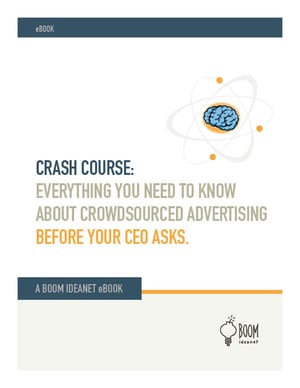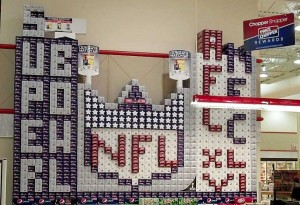Amid the Super Bowl advertising hype, one theme receiving significant attention the past few years is the concept of crowdsourced advertising. At a surface level, crowdsourcing advertising seems to engage a broader audience, break the creative chokehold of advertising agencies, and cost less. The question is, are any of those presumptions about crowdsourcing advertising true?
With that question in mind, I'm excited to introduce Steve Wood of Boom Ideanet to the Brainzooming blog. Steve provides an insider’s perspective AND is introducing a new eBook on crowdsourcing advertising today.
You can download the FREE eBook right here or at the bottom of Steve's guest post and be ready with smart answers and strategies on crowdsourcing advertising when your CEO comes knocking with the idea to crowdsource your next advertising campaign.
Crash Course – Everything You Need to Know About Crowdsourcing Advertising – Before Your CEO Asks by Steve Wood
 This weekend, it’s the Super Bowl® and The Ad Bowl, all wrapped up in one super-hyped package of anticipation. Regardless of how the game goes, the Super Bowl advertising will stir attention and conversation. Doritos®’ “Crash the SuperBowl” campaign will be part of the conversation, in particular because it is crowdsourced. And Doritos is not alone. Lincoln, Coca-Cola, Pepsi, Pizza-Hut and others are spinning crowdsourcing, too.
This weekend, it’s the Super Bowl® and The Ad Bowl, all wrapped up in one super-hyped package of anticipation. Regardless of how the game goes, the Super Bowl advertising will stir attention and conversation. Doritos®’ “Crash the SuperBowl” campaign will be part of the conversation, in particular because it is crowdsourced. And Doritos is not alone. Lincoln, Coca-Cola, Pepsi, Pizza-Hut and others are spinning crowdsourcing, too.
So how does Doritos use a crowd to make its Super Bowl advertising?
Frito-Lay® invests a great deal of time, money and operational structure to mobilize its fan base.
Beginning in 2006, Doritos established a contest for a “fan-made” commercial. They used advertising and other channels to assemble the crowd, which is renewed each year. Crowd members are self-selected. Fans invest in an idea and a finished video. A secondary crowd of voters determines how far an idea goes in the contest.
In year nine, “Crash the Super Bowl” is far more a marketing strategy than a creative strategy. The brand likely spends as much assembling each contest’s crowd as they do airing the winning-spot. They are promoting participation in 29 countries, hosting a website, polling and paying out prize money and benefits totaling over $1M for 30 finalists.
Is this the only way to approach crowdsourcing advertising?
Chances are your company doesn’t have those kinds of resources to apply to one advertising event. You think, “Our company will never do a Super Bowl spot. Maybe it works for Doritos, but how could it work for my brand, or retailers, even B2B companies?” Can crowdsourcing advertising really produce useful results? Is it more trouble than it’s worth? Why would I share my business challenges with a bunch of people we don’t even know? All good questions.
So on the Monday morning after the Super Bowl your CEO will likely ask, “What is this crowdsourcing thing?
Are you prepared to respond?
To get you ready to steer the CEO toward a smart strategy, we’re sharing “Everything You Need to Know About Crowdsourced Advertising Before Your CEO Asks.”
While Doritos has been tapping the crowd one way for years, it’s still anyone’s game out there in crowdsourcing country.
Read the paper. Be the MVP. And at least be ready to play when your CEO asks, “Should we be using “the crowd?" We say Yes! – Steve Wood, Boom Ideanet




